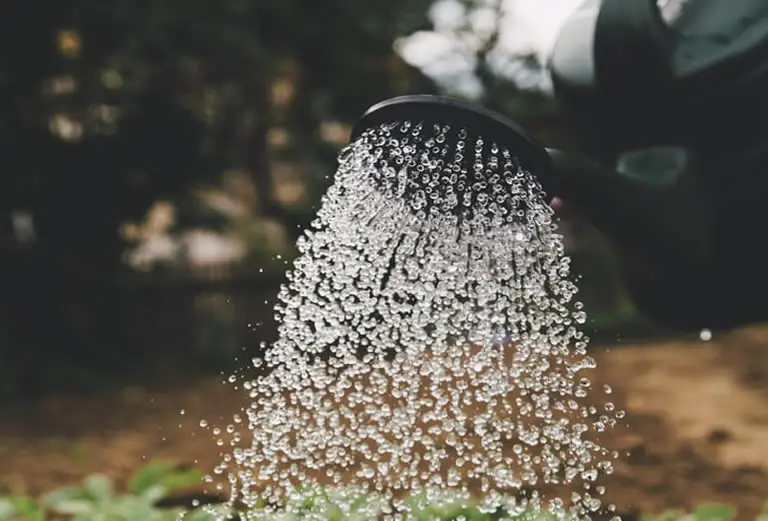In this article I outline everything you need to know about African violets and their water needs. I also cover what happens when you overwater an African violet and the steps you need to take to save your plant.
Table of Contents
- African Violets Watering Care Guide
- How often you should water African violets
- How to know when African violets need water
- How to properly water an African violet – it’s always from the bottom
- How long your African violet should be allowed to sit in water when hydrating the plant
- How often African violets should be watered
- Overwatered African violet problems
- How to know if your African violet has root rot
African Violets Watering Care Guide
By far the most common problems that occur with African violets, from drooping leaves to dead plants, is due to incorrect watering practices. So I intend to make sure you are fully informed about the best way to water your plant.
Prevention is always better than cure so below I give you the best practices for watering an African violet.
The African violet is a tropical plant that likes moist soil but this does not mean it likes soaked soil. Because the plant requires moist soil it is all too easy for someone new to African violets to overwater them. Before I go into the problems that occur from overwatering I’m going to cover the correct watering routine you should follow.
Get your watering routine correct from the beginning and you will never need to deal with the problems that occur from overwatering.
How often you should water African violets
When should you water your African violet?
You should water your African violets every time the soil dries out. African violets thrive in moist soil and a warm humid atmosphere. When the top layer of soil dries, it is time to water your plant.
The period between waterings will greatly depend on the temperature of the environment where the plant grows. The only way to get your watering routine right is to use the soil as a guide.
How to know when African violets need water
The simplest way to know when an African violet needs to be watered is using the “finger test” to gauge how much moisture is in the soil. You do this when the top layer of soil has dried out.
You know when to water African violets by checking the soil for moistness.
Stick your finger into the soil up to the first bend.
If your finger is dry when you remove it, with no soil residue, then your plant needs to be watered. If there is soil residue on your finger when you remove it, then your plant does not need watered.
It is important to understand when an African violet needs to be watered but it is much more important to know when it doesn’t need watered.
I will outline shortly how overwatering an African violet can lead to some nasty and serious side effects.
How to properly water an African violet – it’s always from the bottom
Does an African violet require a particular method of watering?
You should water an African violet from the bottom.
You do this by pouring water into a tray or a small container than is slightly bigger than the plant pot. Sit your potted African violet onto it.
Allow the plant to soak up the water adding additional water to the container if it dries out.
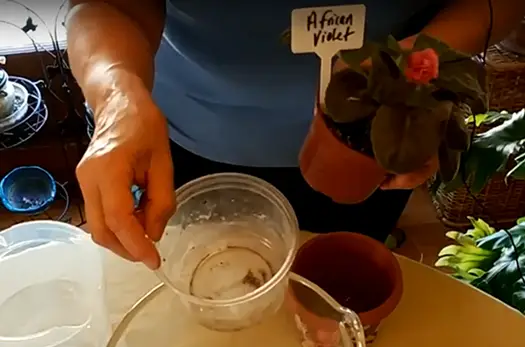
One good reason to always water an African violet from the bottom is to avoid getting water on the leaves. So, when filling the watering container make sure there is plenty of water in it but not so much that the leaves make contact with it when you place the pot inside it. See my guide to African violet leaf care for more information on looking after African violet leaves.
How long your African violet should be allowed to sit in water when hydrating the plant
So when watering an African violet from the bottom how long should it be allowed to sit in water?
African violets should not sit in water any longer than 45 minutes. This is enough time to water the plant sufficiently.
If you used the plant pot tray for watering ensure that any remaining water in the tray is disposed of after this time period before placing the pot back on the tray.
How often African violets should be watered
African violets should be watered every time the top layer of soil dries out. The timing between waterings will be dependent on the temperature of the area where the plant is growing. Always use the soil as a guide.
Use the finger test I mentioned above as a guide to know if your African violet needs watered or not.
Overwatered African violet problems
As I mentioned previously, some of the most common problems I see with African violets are due entirely to overwatering. Even a plant that seems to be lacking water can have its cause in overwatering.
Let’s delve deeper into this subject so I can outline some ways to identify an overwatering problem and also give you steps you can take to save a plant that has been overwatered.
It is very easy to accidently overwater an African violet
A common question among African violet owners is, can you overwatered your plant?
You can overwater an African violet very easily.
Overwatering usually leads to root rot which, if left untreated, will kill your plant. African violets thrive in moist soil but they should not be left in soil that is soaked.
How to know if your African violet is overwatered
One of the main signs that an African violet has been overwatered is root rot. You can identify rot root through the leaves. Drooping leaves even when the soil is moist is common.
Leaves that come away from the plant easily when you touch them and stems that are blacked at the base are also signs your plant has been overwatered.
When African violet leaves have drooping leaves it indicates that the plant is dehydrated. Although it seems counterintuitive to think that overwatering can lead to dehydration that is exactly what happens.
When you overwater an African violet, root sets into the roots preventing them from absorbing nutrients and moisture from the soil. They are then unable to distribute nutrients and water to the rest of the foliage thus leading to plant dehydration.
How to know if your African violet has root rot
Overwatering symptoms are the same as root rot symptom in an African violet because overwatering leads to root rot. I will briefly highlight again how you will know if your African violet has been overwatered and developed root rot.
There will be clear signs that an African violet has root rot in its leaves. Drooping leaves, when the soil is moist, and blackened leaf stems are clear indications of root rot.
Be aware that drooping leaves are not always an indication of root rot, this problem can also be due to lack of water (if the soil is completely dry), lack of nutrients and/or incorrect soil and even a lack of light.
However if the drooping leaves are accompanied by blackened leaf stems and/or the plant soil is still moist and not completely dried out then the problem is almost certainly due to root rot.
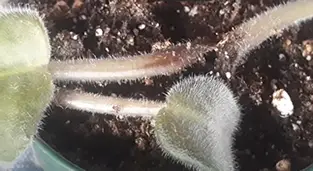
You can see from the image above that the base of the leaves on this African violet plant are showing signs of root rot.
When this plant was removed from its pot the decay in the roots was instantly apparent.
How to fix root rot in African violets
Be aware that the method involved for fixing root rot is the same method you must use to save an overwatered African violet.
To save an overwatered African violet that is in distress you must remove it from its pot and treat it for root rot. I have outlined the steps for doing this below.
How to treat root rot in African violets
You will need:
- Sharp scissors or ordinary shears.
- A small pointed knife.
- A small pot or a styrofoam cup or similar.
- A grow bag or clear plastic, or plastic-alternative, bag.
The first thing you need to do is gently and carefully remove your African violet from its pot being careful not to place any more undue stress on it. You will immediately see signs of rot in the roots as they will be blackened.
As long as there are parts of the lower stem that are unaffected by the rot the plant can be saved. If the rot has infected the entire plant you may not be able to save it and it may be better to take a cutting and try to cultivate a new plant from that.
If your plant still has unaffected stems then begin to cut away the infected roots with clean scissors or shears.
I always wipe my scissors down with a fresh small alcohol wipe after each cut to eliminate the possibility of spreading disease – in case the root rot has been caused by disease rather than overwatering.
When I clean the scissors I am eliminating any potential infection from spreading to the healthier parts of the plant.
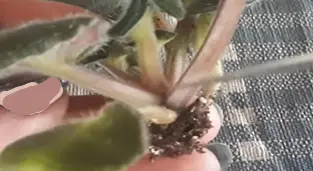
As you can see in the above picture there is still some infected parts of the plant at the base of the stem even after I removed all the roots. This infected area must also be removed.
Taking a pointed knife simply strip away all remaining areas that are showing signs of rot, so that you are only left healthy parts of the plant.
Now that you have removed the infected parts of the plant the African violet should be planted in moist soil that is slightly acidic.
The type of pot you use should be small and suitable for cultivating fresh cuttings or alternatively you can use a simple styrofoam cup. This just makes it easier to spot improvements in the plant and for regulating its care.
At this point the leaves on the African violet will still be dry and dehydrated. However, since you have removed the roots from the plant, this means the plant has no mechanism for absorbing moisture from the soil. To combat this problem you need to create some humidity around the plant. The leaves will then be able to absorb moisture from the air while they wait for new roots to form.
It is easy to create the type of humidity needed by using a small grow bag, a plastic bag or an alternative like these clear bags that are made from plants (which are much more environmentally-friendly).
Place the bag over the plant but before you seal the top (using a clip or stapler), pour a small amount of water down into the sides of the bag so it sits at the bottom of the bag. Don’t pour the water directly into the pot.
Remember that, although African violets drink from the bottom your purpose here is to also create humidity rather than watering the plant.
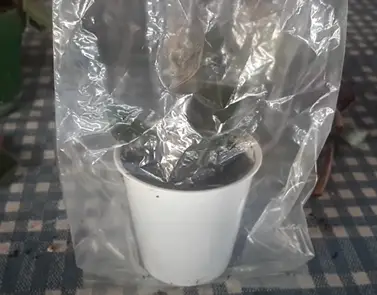
Using a clear bag helps lock in heat and moisture to create a localized humid atmosphere around the plant.
You will know if your efforts have been successful fairly quickly.
If the African violet starts to develop new roots it will only take a few days to see signs of recovery.

